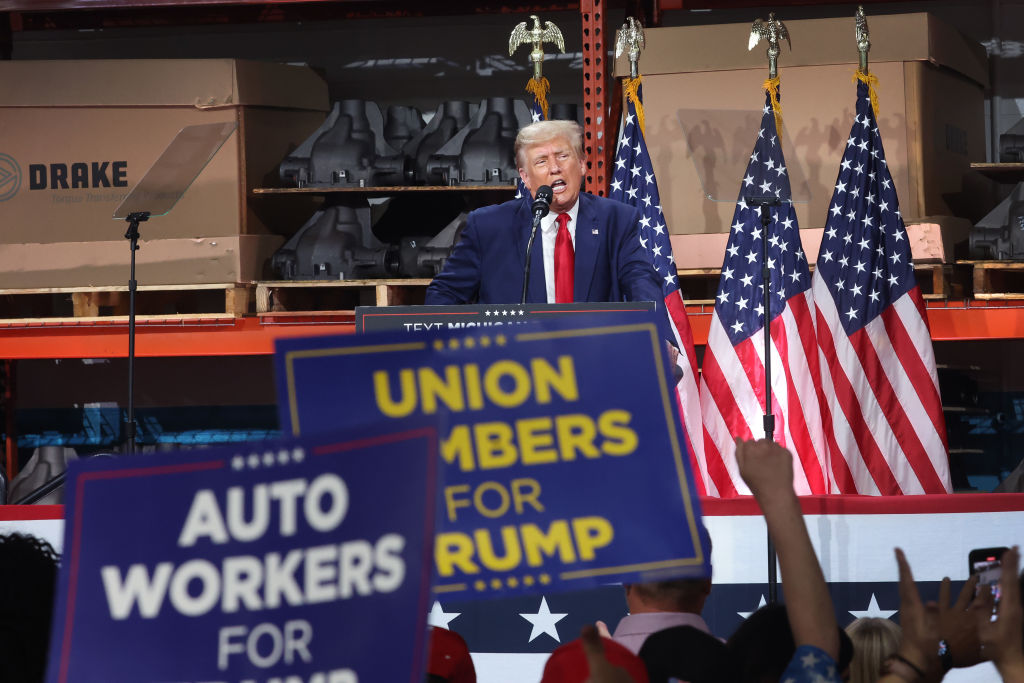The Midwest will decide who wins the White House in November. Much has been written about Kamala Harris’s not-so-subtle appeal to Michigan’s Muslim voters, and her choice of Tim Walz as running mate rounds the ticket out with a Minnesota governor who once praised an extremist Muslim cleric as a “master teacher”.
But away from the cheap tactics of identity politics — which will only fly with so many Midwesterners — Harris and Walz may have more trouble convincing the region of their environmental and industrial policies.
Over the last few months, the drive towards an all-electric auto industry has crashed against technological and economic realities. Electric vehicle mandates, which demand that EVs constitute roughly 70% of all car sales by 2032 (up from 7% today) are extremely ambitious.
Harris, like the Biden administration of which she is an integral part, has been doggedly in favour of these mandates. But now companies such as Ford, Stellantis and Volkswagen have begun to lay off workers or delay new plants due to the weak market. Ford has already cancelled plans to build an all-electric SUV, while Volkswagen has decided not to expand six battery plants in North America and Europe.
These developments, which will no doubt hurt the pockets of Midwesterners, could in turn damage the Democrats. Michigan alone boasts half a million auto workers, with Ohio and Indiana not far behind. The auto industry is also critical to manufacturing everything from steel to machine tools. If car factories disappear, so does much of the industrial infrastructure which supports them. Although Donald Trump is leading in Ohio and was ahead in the most recent polling data from Indiana — which was published before Biden dropped out — some of the strongest concentrations of industrial jobs are found in Wisconsin, a key swing state. Indeed, the Milwaukee area has a higher percentage of jobs in manufacturing than Detroit.
In the coming battle in the Midwest, it’s doubtful EV mandates and their likely impact on jobs will be an effective selling point for the Democrats. Despite progressive claims about a “renaissance” in US manufacturing, and enormous investments in EVs and batteries as well as semiconductors, the industrial sector has been in recession for the better part of the year.
At some point, possibly before November, the economic damage to the Rust Belt could prove decisive. In the first quarter of 2024, Ford lost an average of $44,000 per unit. Other car companies are also losing big on EV sales. This does not bode well for the future of auto manufacturers, which already face increased delinquencies and are obliged to raise prices on conventional vehicles to make up for EV losses.
Auto dealers are raising the alarm. Geoffrey Pohanka, chairman of the National Automobile Dealers Association, complained in a recent RealClearEnergy Webinar that dealerships’ lots are filled with unsold Ford Lightnings, which sell at well above the price of conventional pickups. In a recent survey of 250 “dealership leaders” across the country, half said that their sales teams “weren’t excited at all about selling EVs”. Nor should they be — it’s a tough sell. In July 2023, there were 92,000 unsold EVs stored in dealership lots. In November of that year, nearly 4,000 dealerships across the country asked Joe Biden’s administration to “tap the breaks” on its electric vehicles mandate.
If the dealers are upset, it’s a safe bet that the workers will be too. Overall, electric cars use 30% less domestic labour which could cost at least 30,000 jobs by 2030. Worse still, even if EV sales recover, the bulk of new plants are not likely to be located in the Midwest since the unique skills there will be far less important. In 2014, Elon Musk put his $5-billion gigafactory in low-cost Nevada, and in 2020 he announced that the company’s new $1.1-billion dollar SUV plant, which will employ over 5,000 people, will be built outside Austin, Texas. New battery plants are cropping up in red states, including Kentucky, Ohio, Kansas and Georgia.
EV promoters are counting on Harris to promote policies that will force consumers to buy them, despite clear market resistance. But the current VP won’t be able to remain vague on these green policies forever, even if she may want to keep her anti-oil donors happy.
In places like Michigan, voters are worried about the economy, taxes and immigration — not gestural identity or environmental politics. Readjusted job numbers going down by roughly one million should be a warning to the Democrats. Failure to heed that warning through a continued infatuation with EVs is only more likely to push Midwesterners into Trump’s arms.











Join the discussion
Join like minded readers that support our journalism by becoming a paid subscriber
To join the discussion in the comments, become a paid subscriber.
Join like minded readers that support our journalism, read unlimited articles and enjoy other subscriber-only benefits.
Subscribe